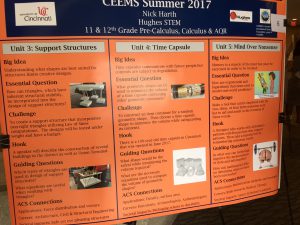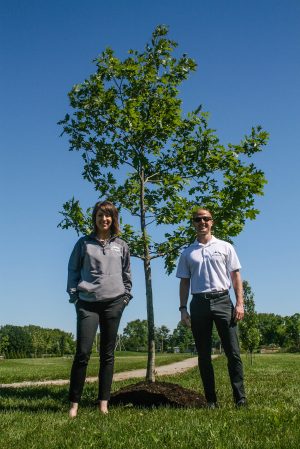Linking Real-World Engineering Problems to K-12 Educators & UC CEEMS
Studies have shown for decades that the integration of STEAM programs within K-12 education is important to the development of students. These programs are designed to set up children earlier with a strong understanding of STEAM skills, while cultivating students as a future interest for national economic prosperity.
Over the past several years Steve Korte, Group Leader for Kleingers’ Southwest Ohio Institutional Group, has volunteered in many ways for the University of Cincinnati CEEMS program. The Cincinnati Engineering Enhanced Mathematics and Science Program (CEEMS) is led by the University of Cincinnati in partnership with 14 Cincinnati-area school districts. One of the main goals of UC’s CEEMS program is “real world applications: connections to engineering,” and the classroom presentations provide great linkage for the students in understanding how the subjects they are learning apply to the “real world.”
 During the program, teachers design a challenged-based learning activity to engage their students in decision making, strategic planning and evaluate plan revisions. At the end of each session, participating teachers are given the opportunity to present their final “units,” displays and videos for judging. Steve served as a volunteer judge during the Closing Day Showcase earlier this month, providing constructive feedback and guidance to the educators.
During the program, teachers design a challenged-based learning activity to engage their students in decision making, strategic planning and evaluate plan revisions. At the end of each session, participating teachers are given the opportunity to present their final “units,” displays and videos for judging. Steve served as a volunteer judge during the Closing Day Showcase earlier this month, providing constructive feedback and guidance to the educators.
“As a graduate of the UC College of Engineering, I take tremendous pride in being able to connect back via CEEMS,” says Steve. “It is a great way for me to give back to my community all while educating the stewards for the next generation of engineers” he continues.
The Oak Hills School District, Steve’s alma mater, is a partner in the CEEMS program. “Many of my formal education worlds come together through the CEEMS program. I have been able to take back my professional experience and college education at UC to teach students about how math and science really come together. I even had the opportunity to present at Delhi Middle School, my old stomping grounds,” Steve shared.
Through many years of volunteering, Steve has grown many relationships with teachers and administrators in the Cincinnati area, which has led to several classroom presentations to middle school and high school math/science students. Steve has also sat on numerous panels in an open forum with math and science teachers to discuss what engineering companies are looking for in college graduates (technical skill sets, software programs and soft skills).
“As a group of engineers, surveyors and landscape architects who use math, arts and sciences every day, it is important to myself and others at Kleingers to educate teachers. Giving teachers the tools to explain real-life applications and how STEAM subjects impact their students’ future careers is huge,” says Steve.
To learn more about the University of Cincinnati’s CEEMS program, visit their website: http://ceas.uc.edu/special_programs/ceems/CEEMS_Home.html
Learn more about the “Closing Day Showcase” here: http://ceas.uc.edu/news-1314/ceems-closing-day-showcase-facilitates-promising-classroom-resul.html
Tree Donated Celebrating 2017 World Landscape Architecture Month

Lynne and Ryan, members of Kleingers’ Landscape Architecture Studio, are on hand for the tree installation.
In celebration of 2017 World Landscape Architecture Month (WLAM), The Kleingers Group generated an online social media campaign to raise awareness for the landscape architecture profession. The campaign gave social media followers the opportunity to vote for their favorite community park designed by Kleingers’ landscape architects. The park with the most votes would receive a shade tree donated by the Kleingers Group. During the month-long landscape architecture celebration, the campaign reached over 10,000 people online and Miller Ecological Park in Lebanon, Ohio was selected to receive the donated tree from Kleingers.
The Miller Ecological Park consists of many sustainable features including a permeable parking lot, bioswales, and many diverse plantings to attract birds and wildlife. Many projects within the park have been donated such as bird boxes, a wildlife blind, an informational kiosk, benches and bleachers, a maintained walking/running trail, bridges, and a gaga pit.
“The City is very thankful for the donation of a beautiful tree in Miller Ecological Park, by Kleingers, as we continue to work on enhancing the park’s natural environment.”
– Scott Brunka, Deputy City Manager, City of Lebanon
The Kleingers Group remains astounded by the level of support each community fostered during our small campaign. We can only hope this effort will inspire others to give back within their own communities. Thank you to all who voted, donated, and celebrated #WLAM17 with us. We look forward to celebrating again next year!
To learn more about the profession and Landscape Architecture Month, visit https://www.asla.org/contentdetail.aspx?id=45783.
Kleingers Trains Miami Students to Build Water Systems in S. America

For more than 13 years, Engineers Without Borders has been building engineering projects that empower communities to meet their basic needs.
With 300 chapters across the United States, more than 15,900 volunteers work together to provide engineering services and have impacted more than 2.5 million lives.
Mike Brunner, Water Resources Group Leader at The Kleingers Group, is currently acting as a mentor for the group, helping to train Miami University students who plan to travel to Ecuador, South America or Rwanda, Africa. Under the guidance of a mentor, the students will provide engineering services to build water systems that ensure the communities have access to water.
In late September, Brunner helped the students learn a variety of hands-on skills and the practice of engineering and surveying theory, including how to run an elevation level circuit, mix and place concrete, construct water piping systems, and test concrete beams.
Particularly popular was the process of breaking beams, which was done by having increasing numbers of students stand on the beams, which were positioned 3 inches off the ground until they broke. This was preceded by reviewing the design calculations and making predictions of how many students it would take to break them and how much they would deflect before breaking.
At an upcoming meeting this weekend, Brunner will help teach the student volunteers about building masonry walls.
Each training session prepares students for civil engineering, surveying, and other experience they may need on their upcoming trip.
“I had been looking for an organization like this, with an opportunity to give back and work with students for a long time,” Brunner said. “This really is a wonderful organization.”
Engineers Without Borders is organized by local chapters that partner directly with communities, mostly international, on projects to meet the community’s self-identified needs. The vast network of dedicated volunteers ranges from first-year engineering students and engineering professionals to public health professionals.
The over-arching philosophy of EWB-USA is to partner with communities in a sustainable way, and through the use of appropriate technology, so that they have ownership in the project(s) and will be able to maintain the project facilities long-term.
Along with two or three other local professional engineers, Brunner meets weekly with the student volunteers to provide advice and direction on the engineering/technical aspects of the project, as well as to guide them through the development of the project documents and EWB-USA paperwork.
Two different teams of Miami students from the chapter, along with a mentor, traveled to Ecuador and Rwanda last year to gather survey data that is being used to design the projects and to meet the local community leaders and citizens. Trips for the construction phase are being planned for this year.
Field Day 2015
Work hard. Play hard.
When we meet our goals, we like to party. Who doesn’t love a bouncy house?